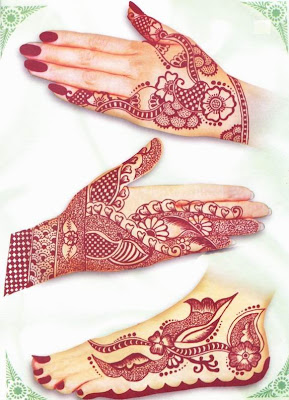
Blog List
Sunday, May 31, 2009
Complex chemistry about Mehindi
Lawsone is the phytochemical constituent of henna leaves, (and hence henna powder) that is responsible for creating the henna stain. The higher the lawsone content of the henna leaves, the deeper the resulting stain produced by the henna powder will be. On average the laswone content of ‘good quality’ henna powder is somewhere between 1% and 2%. The higher the temperatures where the henna is cultivated is directly proportionate to the Lawsone content of the leaves. The higher the temperature, the higher the lawsone content percentage. This is why it is probably no surprise that the best quality henna powders come from some of the hottest regions of the world.
Chemical Formula: C10H6O3Molecular Weight: 174.153g/molCAS Number: 83-72-7EINECS Number: 201-496-3
Substance Name(s):
Lawsone
2-Hydroxy-1,4-napthoquinone
2-Hydroxy-1,4-naphthalenedione
For research purposes it is always worth including as many names and synonyms as possible. Although for the most part henna, lawsonia inermis and lawsone are used in key documentation; there are many older documents that reference the other substance names and/or synonyms. You may also want to research the many common names for henna too.Substance Synonyms:
C.I. 75480
C.I. Natural Orange 6
2-hydroxynapthoquinone
henna
Lawsone, sodium salt
lawsonin
NQ-2-OH
Sodium Lawsonate
Mehindi preparation

Boil some water in a kettle, and then carefully pour the ‘just boiled’ water into a heat resistant container, (a mug for example) only half filling it. Place the unopened catalyst sachet into the mug of very hot water for a few minutes to heat it through thouroughly. Remove it carefully and turn it over a few times to ensure it is well mixed.
Step 2
Make sure the sticker is still securing the tip of the cone, keeping the henna powder out of the tip, ready for mixing with the hot catalyst solution (dry powder in the tip is very hard to mix into the paste and results in blocking the tip.) Then cut open the catalyst sachet & carefully pour hot contents into the henna cone. Then cut open the wide end of the henna cone ready to pour in the hot catalyst solution.
Step 3
Gently manipulate the henna cone, mixing the henna powder & catalyst solution together for 2-3 minutes. Taking care to ’smooth out’ any lumps of henna powder and to ‘work in’ any remaining liquid. When you are happy with the smooth consistency of the henna paste, remove the sticker and move the product up and down the cone for its final mix. Leave to stand for 4-6 hours before use.
Step 4
Cut the tip of the henna cone very close to the end, a small hole makes fine line work possible. If you prefer to work with a thicker line, then just cut a little more off the tip of the cone. Then gently squeeze the henna paste towards the tip of the cone, and use a rubber-band to seal up the wide open end of the cone. You can also use various tapes or a heat sealer to seal the back of the cone if you prefer.
About Henna

As the body sheds its dead skin cells naturally, the henna stained epidermal cells are shed and replaced with new skin cells that have not been stained with henna. Hence the Henna Tattoo will begin to gradually fade away, until it has completely disappeared.
On average a Henna Tattoo generally lasts between 10-15 days, it can sometimes take a further 7 days to completely disappear.
The specific fading timescale for a Henna Tattoo is dependent upon the area of your body where it is applied, as well as your skin type and lifestyle at the time.
As a general rule, Henna Tattoos on the face and neck fade away within 1 week because the epidermis is thinner, continuously exposed to the elements and washed and dried more frequently than other areas of the body. Whereas Henna Tattoos on the arms tend to last for around 2 weeks, because the epidermis is thicker, and more protected from the elements etc…
Your lifestyle also effects the fading time of your Henna Tattoo. If you are in and out of swimming pools, saunas & hot tubs etc… you will encourage your body to regenerate its skin at an accelerated rate, hence shortening the lifespan of your Henna Tattoo.















